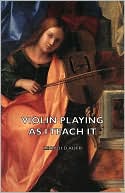

 |

|

The average rating for Violin Playing as I Teach It based on 2 reviews is 3.5 stars.
Review # 1 was written on 2017-08-06 00:00:00 Janna Kopacki Janna KopackiNot as scientific as the amazing and all-inclusive Art of Playing of the Violin by Carl Flesch but it's still a great read, every violinist should get familiar with this book by Leopold Auer |
Review # 2 was written on 2008-03-26 00:00:00 Shawn Jones Shawn JonesA curious work. It does not remotely live up to the blurb at this site as far as imparting much technical violin wisdom. It has a lot more to do with some of Auer's opinions, memories, and taste. I have the impression that this book was written by the exiled post-1917 Auer from economic necessity and to exploit his name for profit. It is a slight volume interesting on its own terms. For the benefit of those who are not familiar with its author. Leopold Auer was a prominent violinist of the nineteenth century who got a the job of running the music school at St. Petersburg along with distinguished colleagues such as Nicolas Rubenstein (brother of the famous pianist Anton Rubenstein). This task was very demanding and left him with little time for performance (which is Auer's explanation for his neglect of the the Tchaikowksy concerto originally dedicated to him, but that is not discussed in this book). While in this post he was the recipient one of the greatest bounties ever bestowed upon a violin pedagogue, a monopoly on the talent pool of the Russian Jewish Pale of Settlement of western Russia. The residents of the pale could not freely move outside the pale. One exception was to be a student at the school in St. Petersburg. From this captivity emerged a stream of fabulous artists such as Elman, Seidel, Milstein and Heifetz. The exploits of these giants made his reputation as a teacher around the world, surpassing that of any other "school" of the time. To his credit, he did no harm to these prodigies, as for example a lesser pedagogue such as Joachim would have. But on the other hand his operation was sufficiently hands-off that it cannot be said that he made them either. Heifetz in particular arrived all but ready-made. (In other accounts Heifetz gives Auer credit for polishing him up socially and in proper public presentation, violinistically there was not much left to add.) All the same he did expedite the passage of these artists, with their individuality intact, to the world stage (and recordings) and for that we can be grateful. In the book, there are many reflections about the discovery and development of his more famous students. For example, Elman was having some problems with the Tchaikowsky concerto, so the author tells him to get it or he will have to do something else, and viola, Elman pulls it off. One can do this with with great talent Auer notes. And his bemused observation that Seidel and Heifetz seem to have no nerves at all, in constrast to the author who apparently has a more abundant (that is, normal) supply of stage fright. I found among his recollections some strange tastes. For example, he regards the Bach violin concerti (a minor and E major) as inferior works with the exception of the d minor double concerto. On the other hand he extolls the virtues of Bazzini's Ronde de Lutins, a small, charming and extremely technical display piece but no landmark of composition. It is very enjoyable as a collection of opinions and recollections but is not any kind of comprehensive treatise on his methods as suggested by the title. Auer also wrote a more substantial autobiography, My Long Life In Music, but it is not so easy to obtain at the moment. |
CAN'T FIND WHAT YOU'RE LOOKING FOR? CLICK HERE!!!